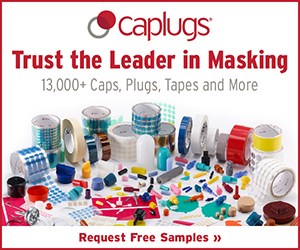Recoating Over Powder
Products Finishing powder coating columnist Rodger Talbert discusses procedures for the successful recoating of powder coated parts.

Rodger Talbert has more than 30 years of experience in the powder coating industry.
Q: We work hard to get a good coating on our parts, but we sometimes need to recoat a part due to minor defects. I am having a lot of trouble getting good attraction to the surface and getting a good-looking and consistent second coat. We get some dull-looking areas sometimes and occasionally a grainy look. We also sometimes have trouble with adhesion of the second coat. Can you give some advice on recoating and ways to make it work more reliably?
A: Successful recoating starts with understanding the powder you are using. Some powder materials will adhere to the first coating with no problem and no special preparation. Some materials do not have good intercoat adhesion properties and may require some surface preparation to promote intercoat adhesion. In all cases, it is important to ensure the surface is clean and dry. You can do that by rinsing the surface and running it through your dry-off oven. With some powder materials, it is necessary to scuff sand the surface to ensure good adhesion of the second coat. Some trials can tell you if a powder has to be sanded before a recoat.
As for the appearance, keep in mind that powder is attracted to the grounded part surface by electrostatic attraction. The powder particle is loaded with electrons seeking earth ground to bleed back into the atmosphere. When they come in contact with the bare metal, the electrical charge will begin to dissipate from the powder to ground. All of the charge does not immediately go to ground and the material will cling to the bare metal for a long time. As the layer builds, the surface becomes somewhat insulated and the attraction gradually diminishes due to a reduction in the pull of earth ground. The cured powder surface is insulated and the earth ground attraction is very low. The application efficiency during a recoat is lower due to resistance from the first coating. The surface of the part is covered and it will reach a point where the charged powder on the part is at, or near, the same potential as the powder being applied, thereby creating back ionization or rejection.
The gun settings for the application of a second coat should be modified to compensate for the resistance of the first coat. The electrostatic charge should be reduced (either by lowering voltage or limiting current). The gun-to-part distance should be increased slightly to soften the forward velocity of the pattern and further reduce the current draw to the part. It is also helpful to adjust the powder delivery settings to increase the output by 10-20%. Be aware that the application will require more time and transfer efficiency will decrease when doing re-coats but application is possible. The reduction in charge, combined with a slight increase in flow rate and keeping the gun farther from the target, should provide the coverage needed. In order to avoid the dull areas and grainy appearance, be sure to cover the entire part thoroughly.
Related Content
How to Choose the Right Coating for Fasteners
Choosing the proper coating for fasteners can help with performance by improving durability and lifespan. In this helpful Ask the Expert article, Mark Schario of Columbia Chemical offers advice for choosing the right fastener coatings.
Read MoreCrazing and Cracking in Anodizing
Understanding the differences in cracking and crazing in anodic coatings, and insights for mitigating defects in anodized parts.
Read MoreOutgassing and Powder Coating Defects
Having trouble with bubbles forming during curing? Verney Denerville of TIGER Drylac discusses proper outgassing procedures.
Read MoreImproving Transfer Efficiencies in Coating Operations
There are many methods for addressing electrostatic grounding in metal painting processes, and Tim Ulshafer from Mueller Electric says the best method for your process is a simple and worthwhile exercise.
Read MoreRead Next
The Powder Coating Process
Powder coating is one of the most durable finishes that can be applied to industrial manufactured products, and offers excellent corrosion protection and is very safe because of its lack of volatile organic compounds. To understand the powder coating process you should start with the fundamentals.
Read MoreRecycling Powder
Powder coating expert Kevin Biller of ChemQuest Powder Coating Research discusses options for recycling powder.
Read MoreChoosing the Right Powder Booth
Tim Chambers of Carlisle Fluid Technologies discusses considerations for selecting a powder booth.
Read More























